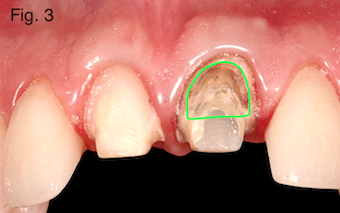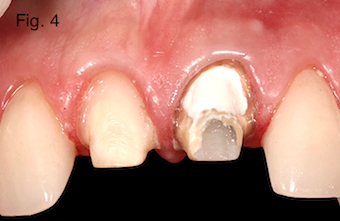Restoring Discolored Endodontically Treated Teeth: Case 5
By Frank Spear on October 22, 2018 |In a previous article in this series I showed an example of masking an extremely dark crown prep by using an opaque cored crown and subgingival margin. This article will discuss using an opaque masking agent and opacious composite to allow the use of a more translucent final restoration.
Discolored endodontically-treated central incisor, existing metal ceramic crowns
This patient presented unhappy with the appearance of his old metal ceramic crowns and the wear on his other anterior teeth. In addition, the gingival levels of the centrals would benefit from crown lengthening, particularly the right central (Fig. 1). Removing the crowns revealed an extremely dark prep on the left central (Fig. 2).
In the previous article I showed a similar prep masked with an Alumina core. In this case I was also restoring the right central, both laterals and canines, all which were normal in color. I decided to mask the prep with a highly opaque material (Kerr Kolor-Plus), followed by an opacious composite (3M Filtek Supreme shade A-1 dentin).
This allows the technician to use a more translucent final restoration, which ultimately makes it easier to match the other restorations. The masking is done by prepping an additional few tenths of a millimeter into the darker areas, followed by etching and bonding, then the Kolor-Plus to mask, overlayed by the composite to bring the shade closer to normal (Fig. 2-4).




In this case, the technician chose powder and liquid ceramics for the veneers, and Zirconia cores with powder and liquid ceramics over the cores layered very similar to the veneers. This case could have been done similar to case four in the previous article, where I did all the masking with the opaque core of the final restoration, but I would have used the opaque cores on both centrals to achieve an acceptable match between them.

The composite masking meant I didn’t need to use the opaque core on either central. Since the left central required a subgingival margin to hide the junction of light and dark, I also placed the margin of the right central subgingival to get a good match, even though all the veneers on the laterals and canines have supragingival margins (Fig. 5).
(Click this link for more dentistry articles by Dr. Frank Spear.)
Don't Leave Yet!
You'll miss the best part - something for FREE! We have a whole library of courses about endodontic diagnosis and treatement, and we're offering you a free Spear Online demo so you can experience for yourself why thousands of dentists have joined us. Take advantage of the free demo today and decide for yourself.
GET YOUR FREE DEMO